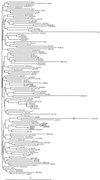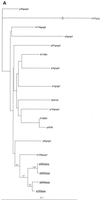Molecular investigation of transmission of human immunodeficiency virus type 1 in a criminal case - PubMed (original) (raw)
Case Reports
Molecular investigation of transmission of human immunodeficiency virus type 1 in a criminal case
R Machuca et al. Clin Diagn Lab Immunol. 2001 Sep.
Abstract
Very few criminal cases involving human immunodeficiency virus type 1 (HIV-1) transmission have been described. We report on an HIV-1 transmission case with a child being infected by an HIV-1-positive man. The objective was to determine through molecular epidemiology and phylogenetic analyses whether HIV-1 from the HIV-1-positive man could be the source of infection in the HIV-1-positive child, as claimed by the authorities. We conducted genetic analysis of three different parts of the HIV-1 genome (gag, pol, and env) by PCR, direct-sequencing, and phylogenetic analyses. We used maximum likelihood, maximum parsimony, and neighbor-joining methods for the phylogenetic analyses to investigate whether the sequences from the man and the child were related. We found that the viral sequences from the man and the child formed separate clusters in all of the phylogenetic analyses compared to the local controls. A unique amino acid deletion was identified in the C2-V3-C3 region of the env gene in the virus from the man and the child. These results were used in the criminal court to elucidate whether the virus from the man was related to the virus from the child. In summary, the results from the phylogenetic analyses, the sequence distances between the virus from the man and the virus from the child, and the identification of the unique molecular fingerprint in the env gene together indicated that the virus from the man and the virus from the child were epidemiologically linked.
Figures
FIG. 1
Alignment of the amino acid sequences derived from the C2-V3-C3 region. The child's sequences correspond to the pt843t and pt843rt samples, and the sequences from the man correspond to the pt844t and v3prot165 samples. An asterisk indicates the described deletion between the child and the man. A minus sign indicates an amino acid that corresponds to the consensus sequence. Deletions in the amino acid alignment are indicated by a period. “X” corresponds to an amino acid mixture.
FIG. 2
Phylogenetic tree derived from sequences from the C2-V3-C3 region. A total of 101 subtype B C2-V3-C3 sequences obtained from the Los Alamos database were included in the analyses, together with the 16 local control sequences (in boldface) and the four sequences from the man and the child (in boldface and underlined). The NJ method was used in constructing the tree. An HIV-1 subtype A sequence, U455, was used as an outgroup. The two lines (∥) on the outgroup indicate that the branch has been shortened.
FIG. 3
(A) Phylogenetic tree derived from sequences from the p17gag region. (B) Phylogenetic tree derived from sequences from the C2-V3-C3 region. (C) Phylogenetic tree derived from sequences from the p17gag region and the C2-V3-C3 region combined. (D) Phylogenetic tree derived from sequences from the RT region of the pol gene. The NJ method was used in constructing all four trees. An HIV-1 subtype A sequence, U455, was used as an outgroup. The two lines (∥) on the outgroup indicate that the branch has been shortened. Only relevant bootstrap values have been included in the tree. Local controls are in boldface. The four sequences from the man and the child are in boldface and underlined.
FIG. 3
(A) Phylogenetic tree derived from sequences from the p17gag region. (B) Phylogenetic tree derived from sequences from the C2-V3-C3 region. (C) Phylogenetic tree derived from sequences from the p17gag region and the C2-V3-C3 region combined. (D) Phylogenetic tree derived from sequences from the RT region of the pol gene. The NJ method was used in constructing all four trees. An HIV-1 subtype A sequence, U455, was used as an outgroup. The two lines (∥) on the outgroup indicate that the branch has been shortened. Only relevant bootstrap values have been included in the tree. Local controls are in boldface. The four sequences from the man and the child are in boldface and underlined.
FIG. 3
(A) Phylogenetic tree derived from sequences from the p17gag region. (B) Phylogenetic tree derived from sequences from the C2-V3-C3 region. (C) Phylogenetic tree derived from sequences from the p17gag region and the C2-V3-C3 region combined. (D) Phylogenetic tree derived from sequences from the RT region of the pol gene. The NJ method was used in constructing all four trees. An HIV-1 subtype A sequence, U455, was used as an outgroup. The two lines (∥) on the outgroup indicate that the branch has been shortened. Only relevant bootstrap values have been included in the tree. Local controls are in boldface. The four sequences from the man and the child are in boldface and underlined.
FIG. 3
(A) Phylogenetic tree derived from sequences from the p17gag region. (B) Phylogenetic tree derived from sequences from the C2-V3-C3 region. (C) Phylogenetic tree derived from sequences from the p17gag region and the C2-V3-C3 region combined. (D) Phylogenetic tree derived from sequences from the RT region of the pol gene. The NJ method was used in constructing all four trees. An HIV-1 subtype A sequence, U455, was used as an outgroup. The two lines (∥) on the outgroup indicate that the branch has been shortened. Only relevant bootstrap values have been included in the tree. Local controls are in boldface. The four sequences from the man and the child are in boldface and underlined.
Similar articles
- [Distribution of recombinant human immunodeficiency virus type-1 CRF01_AE strains in China and its sequence variations in the env V3-C3 region].
Xing H, Liang H, Wan ZY, Chen X, Wei M, Ma PF, Guan Q, Quan Y, Hong KX, Shao YM. Xing H, et al. Zhonghua Yu Fang Yi Xue Za Zhi. 2004 Sep;38(5):300-4. Zhonghua Yu Fang Yi Xue Za Zhi. 2004. PMID: 15498240 Chinese. - [Study on the evolutionary pressure on the env gene of the human immunodeficiency virus type 1 CRF01-AE strains circulating in China].
Liang H, Xing H, Wei M, Chen Z, Guan Q, Huang HL, Quan Y, Chen JP, Hong KX, Shi LY, Shao YM. Liang H, et al. Zhonghua Liu Xing Bing Xue Za Zhi. 2003 Nov;24(11):966-70. Zhonghua Liu Xing Bing Xue Za Zhi. 2003. PMID: 14687493 Chinese. - Molecular analysis of human immunodeficiency virus strains associated with a case of criminal transmission of the virus.
Birch CJ, McCaw RF, Bulach DM, Revill PA, Carter JT, Tomnay J, Hatch B, Middleton TV, Chibo D, Catton MG, Pankhurst JL, Breschkin AM, Locarnini SA, Bowden DS. Birch CJ, et al. J Infect Dis. 2000 Sep;182(3):941-4. doi: 10.1086/315751. Epub 2000 Aug 17. J Infect Dis. 2000. PMID: 10950794 - Molecular biological assessment methods and understanding the course of the HIV infection.
Katzenstein TL. Katzenstein TL. APMIS Suppl. 2003;(114):1-37. APMIS Suppl. 2003. PMID: 14626050 Review. - Phylogenetic analysis as a forensic tool in HIV transmission investigations.
Abecasis AB, Pingarilho M, Vandamme AM. Abecasis AB, et al. AIDS. 2018 Mar 13;32(5):543-554. doi: 10.1097/QAD.0000000000001728. AIDS. 2018. PMID: 29280759 Review.
Cited by
- Forensic genetics and genomics: Much more than just a human affair.
Arenas M, Pereira F, Oliveira M, Pinto N, Lopes AM, Gomes V, Carracedo A, Amorim A. Arenas M, et al. PLoS Genet. 2017 Sep 21;13(9):e1006960. doi: 10.1371/journal.pgen.1006960. eCollection 2017 Sep. PLoS Genet. 2017. PMID: 28934201 Free PMC article. Review. - Non-disclosed men who have sex with men within local MSM HIV-1 genetic transmission networks in Guangyuan, China.
Zhuoma L, Zhang Y, Yan T, Kang F, Hou X, Chen J, Huang M, Zeng Y, Wang Q, Zhou C, Liang S, Su L. Zhuoma L, et al. Front Public Health. 2022 Aug 9;10:956217. doi: 10.3389/fpubh.2022.956217. eCollection 2022. Front Public Health. 2022. PMID: 36117593 Free PMC article. - Molecular evolution in court: analysis of a large hepatitis C virus outbreak from an evolving source.
González-Candelas F, Bracho MA, Wróbel B, Moya A. González-Candelas F, et al. BMC Biol. 2013 Jul 19;11:76. doi: 10.1186/1741-7007-11-76. BMC Biol. 2013. PMID: 23870105 Free PMC article. - Outbreak of HIV Infection Linked to Nosocomial Transmission, China, 2016-2017.
Pan X, Jiang J, Ma Q, Zhang J, Yang J, Chen W, Ding X, Fan Q, Guo Z, Xia Y, Xia S, Wu Z. Pan X, et al. Emerg Infect Dis. 2018 Dec;24(12):2141-2149. doi: 10.3201/eid2412.180117. Emerg Infect Dis. 2018. PMID: 30457542 Free PMC article. - Source identification in two criminal cases using phylogenetic analysis of HIV-1 DNA sequences.
Scaduto DI, Brown JM, Haaland WC, Zwickl DJ, Hillis DM, Metzker ML. Scaduto DI, et al. Proc Natl Acad Sci U S A. 2010 Dec 14;107(50):21242-7. doi: 10.1073/pnas.1015673107. Epub 2010 Nov 15. Proc Natl Acad Sci U S A. 2010. PMID: 21078965 Free PMC article.
References
- Bobkov A, Garaev M M, Rzhaninova A, Kaleebu P, Pitman R, Weber J N, Cheingsong-Popov R. Molecular epidemiology of HIV-1 in the former Soviet Union: analysis of env V3 sequences and their correlation with epidemiologic data. AIDS. 1994;8:619–624. - PubMed
- Bruun L, Katzenstein T, Gerstoft J, Petersen C, Mathiesen L R, Nielsen C. Development of Lys to Arg mutation at codon 70 of the reverse transcriptase gene of HIV-1 during zidovudine monotherapy and alternating zidovudine/didanosine therapy. Antivir Ther. 1998;3:89–95.
Publication types
MeSH terms
LinkOut - more resources
Full Text Sources
Miscellaneous


